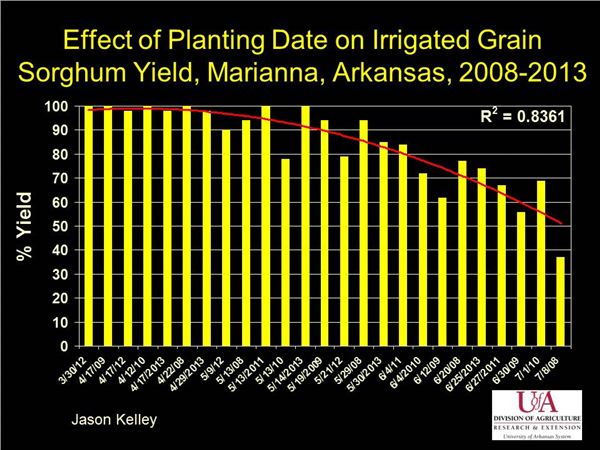Grain Sorghum Planting Dates And Sugarcane Aphids
DR. JASON KELLEY
LITTLE ROCK, ARK.
It seems we have been stuck in a wet weather pattern since Mid-February that has delayed top-dress nitrogen on wheat, limited field work and has slowed planting progress of most of our summer crops. Some areas of the state have been fortunate and have been able to get a good portion of their acres planted, while much of Northeast Arkansas has been too wet to make much planting progress. Many are planting grain sorghum for the first time in several years and had hoped to have their crop in the ground by now to maximize yield and potentially lessen the impact of sugarcane aphid on the crop. As of April 13th, the Arkansas Agriculture Statistics Service indicated that 14 percent of the grain sorghum had been planted compared to only 6 percent last year and 29 percent for the 5-year average. The good news is, we are ahead of where we were last year, but still running slightly behind on planting. Overall little planting occurred last week and many are hopeful that later this week fields will be dry enough to get back in to plant.
With the delay in planting grain sorghum, producers may be wondering how late can we plant and maintain maximum grain yield. In a 6-year study I conducted at Marianna, yields of irrigated grain sorghum started to slowly decline once we got into an early-mid May planting date (See chart below). Yields were consistently good with April plantings and tended to decline and become more variable the later in May we planted. In these trials, on average, we maintained 90 percent of our yield potential through mid-May. Of course if you are further south or north of Marianna, sliding up or back these dates would most likely reflect potential in your area. Each year is different, but years with rainfall and relatively mild temperatures during July are likely to extend the time frame when maximum yields can be achieved, while the opposite is true if hot and dry weather sets in early.
This year, another consideration is what impact the sugarcane aphid may have on late April or May planted grain sorghum. Last year, our first year to deal with this pest, April to early May planted grain sorghum was much less impacted by the sugarcane aphid than later planted grain sorghum. The later grain sorghum was planted, the longer time period that aphid populations had to build up and become a problem. The same is true with our traditional grain sorghum pests including sorghum midge, whorl feeders, and headworms in that insect pest pressure will be greater with late plantings. Remember that the broad-spectrum pyrethroid insecticides often used to control midge will flare sugarcane aphids, so reducing midge pressure by planting early can also help with aphid management.
We still have time to plant grain sorghum, but hopefully we can get planted sooner than later. ∆
DR. JASON KELLEY: Wheat & Feed Grains Extension Agronomist, University of Arkansas
